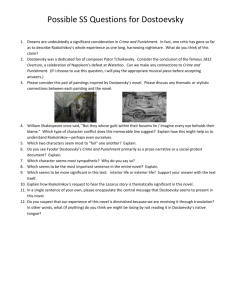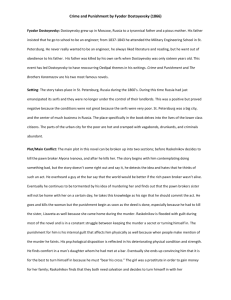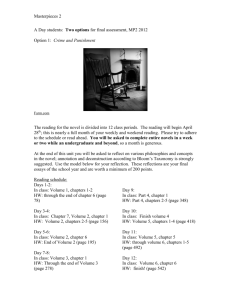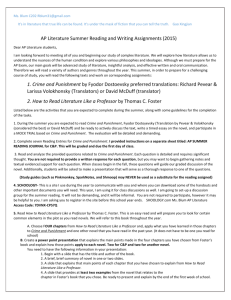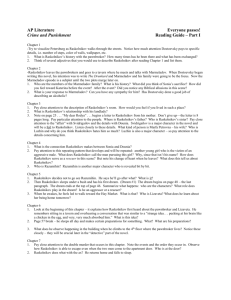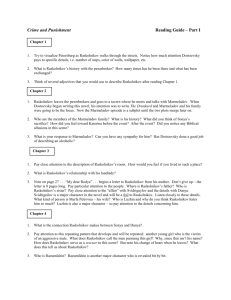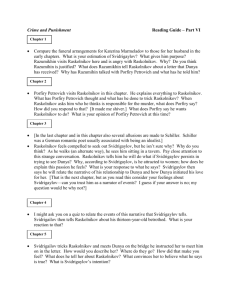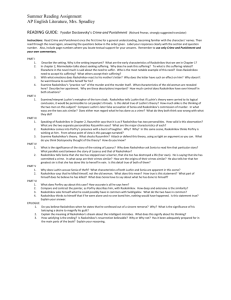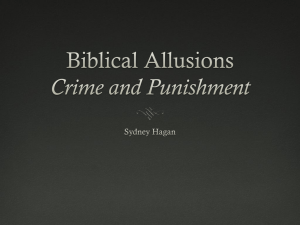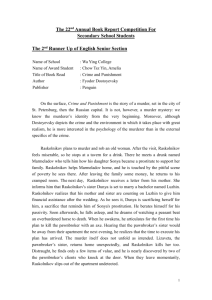Traditional Symbolism in Crime and Punishment
advertisement
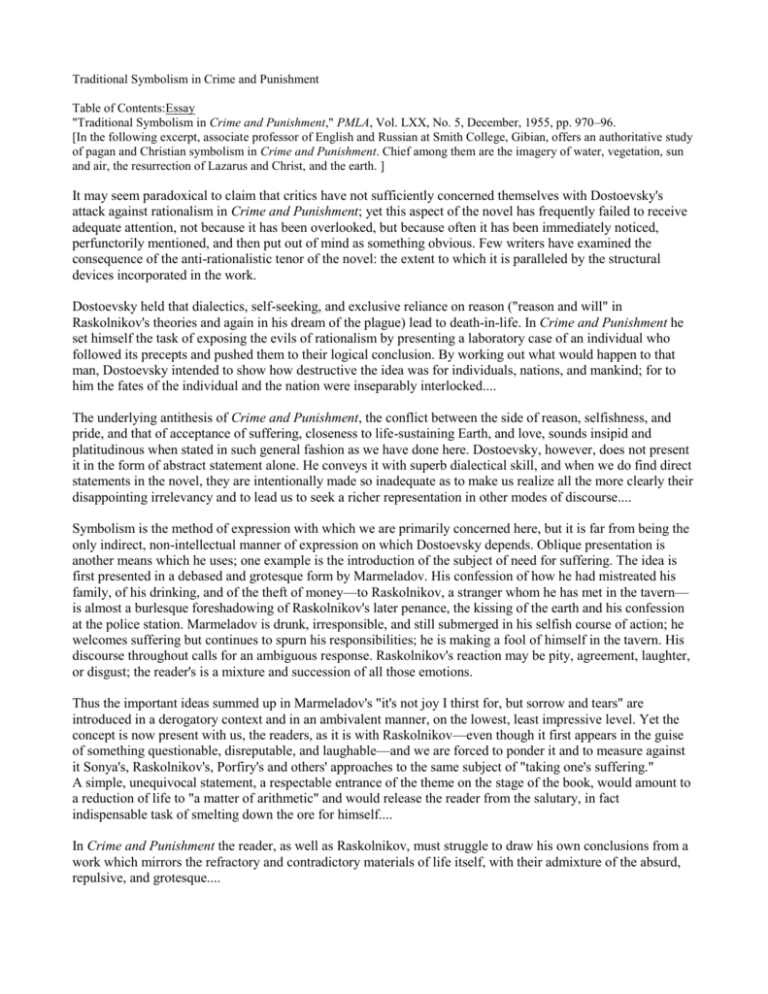
Traditional Symbolism in Crime and Punishment Table of Contents:Essay "Traditional Symbolism in Crime and Punishment," PMLA, Vol. LXX, No. 5, December, 1955, pp. 970–96. [In the following excerpt, associate professor of English and Russian at Smith College, Gibian, offers an authoritative study of pagan and Christian symbolism in Crime and Punishment. Chief among them are the imagery of water, vegetation, sun and air, the resurrection of Lazarus and Christ, and the earth. ] It may seem paradoxical to claim that critics have not sufficiently concerned themselves with Dostoevsky's attack against rationalism in Crime and Punishment; yet this aspect of the novel has frequently failed to receive adequate attention, not because it has been overlooked, but because often it has been immediately noticed, perfunctorily mentioned, and then put out of mind as something obvious. Few writers have examined the consequence of the anti-rationalistic tenor of the novel: the extent to which it is paralleled by the structural devices incorporated in the work. Dostoevsky held that dialectics, self-seeking, and exclusive reliance on reason ("reason and will" in Raskolnikov's theories and again in his dream of the plague) lead to death-in-life. In Crime and Punishment he set himself the task of exposing the evils of rationalism by presenting a laboratory case of an individual who followed its precepts and pushed them to their logical conclusion. By working out what would happen to that man, Dostoevsky intended to show how destructive the idea was for individuals, nations, and mankind; for to him the fates of the individual and the nation were inseparably interlocked.... The underlying antithesis of Crime and Punishment, the conflict between the side of reason, selfishness, and pride, and that of acceptance of suffering, closeness to life-sustaining Earth, and love, sounds insipid and platitudinous when stated in such general fashion as we have done here. Dostoevsky, however, does not present it in the form of abstract statement alone. He conveys it with superb dialectical skill, and when we do find direct statements in the novel, they are intentionally made so inadequate as to make us realize all the more clearly their disappointing irrelevancy and to lead us to seek a richer representation in other modes of discourse.... Symbolism is the method of expression with which we are primarily concerned here, but it is far from being the only indirect, non-intellectual manner of expression on which Dostoevsky depends. Oblique presentation is another means which he uses; one example is the introduction of the subject of need for suffering. The idea is first presented in a debased and grotesque form by Marmeladov. His confession of how he had mistreated his family, of his drinking, and of the theft of money—to Raskolnikov, a stranger whom he has met in the tavern— is almost a burlesque foreshadowing of Raskolnikov's later penance, the kissing of the earth and his confession at the police station. Marmeladov is drunk, irresponsible, and still submerged in his selfish course of action; he welcomes suffering but continues to spurn his responsibilities; he is making a fool of himself in the tavern. His discourse throughout calls for an ambiguous response. Raskolnikov's reaction may be pity, agreement, laughter, or disgust; the reader's is a mixture and succession of all those emotions. Thus the important ideas summed up in Marmeladov's "it's not joy I thirst for, but sorrow and tears" are introduced in a derogatory context and in an ambivalent manner, on the lowest, least impressive level. Yet the concept is now present with us, the readers, as it is with Raskolnikov—even though it first appears in the guise of something questionable, disreputable, and laughable—and we are forced to ponder it and to measure against it Sonya's, Raskolnikov's, Porfiry's and others' approaches to the same subject of "taking one's suffering." A simple, unequivocal statement, a respectable entrance of the theme on the stage of the book, would amount to a reduction of life to "a matter of arithmetic" and would release the reader from the salutary, in fact indispensable task of smelting down the ore for himself.... In Crime and Punishment the reader, as well as Raskolnikov, must struggle to draw his own conclusions from a work which mirrors the refractory and contradictory materials of life itself, with their admixture of the absurd, repulsive, and grotesque.... Traditional symbolism, that is, symbolism which draws on images established by the Christian tradition and on those common in Russian non-Christian, possibly pre-Christian and pagan, folk thought and expression, is an important element in the structure of Crime and Punishment. The outstanding strands of symbolic imagery in the novel are those of water, vegetation, sun and air, the resurrection of Lazarus and Christ, and the earth. Water is to Dostoevsky a symbol of rebirth and regeneration. It is regarded as such by the positive characters, for whom it is an accompaniment and an indication of the life-giving forces in the world. By the same token, the significance of water may be the opposite to negative characters. Water holds the terror of death for the corrupt Svidrigaylov, who confirms his depravity by thinking: "Never in my life could I stand water, not even on a landscape painting." Water, instead of being an instrument of life, becomes for him a hateful, avenging menace during the last hours of his life.... Indeed it will be in the cold and in the rain that he will put a bullet in his head. Instead of being a positive force, water is for him the appropriate setting for the taking of his own life. When Raskolnikov is under the sway of rationalism and corrupting ways of thinking, this also is indicated by Dostoevsky by attributing to him negative reactions to water similar to those of Svidrigaylov. In Raskolnikov, however, the battle is not definitely lost. A conflict still rages between his former self—which did have contact with other people and understood the beauty of the river, the cathedral (representing the traditional, religious, and emotional forces), and water—and the new, rationalistic self, which is responsible for the murder and for his inner desiccation.... There is still left in Raskolnikov an instinctive reaction to water (and to beauty) as an instrument of life, although this receptivity, which had been full-blown and characteristic of him in his childhood, is now in his student days overlaid by the utilitarian and rationalistic theories.... But Raskolnikov also realizes that his trends of thought have banished him, like Cain, from the brotherhood of men and clouded his right and ability to enjoy beauty and the beneficent influences of life symbolized by water; hence his perplexity and conflict.... Related to the many references to the river and rain, and often closely associated with them, are two other groups of symbolic imagery: that of vegetation (shrubbery, leaves, bushes, flowers, and greenness in general) and that of the sun (and the related images of light and air). In contrast to the dusty, hot, stifling, and crowded city, a fitting setting for Raskolnikov's oppressive and murderous thoughts, we find, for example, "the greenness and the freshness" of the Petersburg islands.... The natural surroundings reawakened in him the feelings of his youth, through which he came close to avoiding his crime and to finding regeneration without having to pass through the cycle of crime and punishment.... By the same token, vegetation exercised the opposite effect on Svidrigaylov: it repelled him. In the inn on the night of his suicide, when he heard the leaves in the garden under his window, he thought, "How I hate the noise of trees at night in a storm and in darkness." Whereas Raskolnikov received a healthy warning during his short sleep "under a bush," Svidrigaylov uses the sordid setting of an amusement park which "had one spindly threeyear-old Christmas tree and three small bushes" merely for vain distraction on the eve of his suicide, and contemplates killing himself under "a large bush drenched with rain." In him all positive elements had been rubbed out or transformed into evil. Similarly to water and vegetation, sunshine, light in general, and air are positive values, whereas darkness and lack of air are dangerous and deadening. The beauty of the cathedral flooded by sunlight ought to be felt and admired.... Before the murder, he looks up from the bridge at the "bright, red sunset" and is able to face the sun as well as the river with calm, but after the murder, "in the street it was again unbearably hot—not a drop of rain all during those days.... The sun flashed brightly in his eyes, so that it hurt him to look and his head was spinning round in good earnest—the usual sensation of a man in a fever who comes out into the street on a bright, sunny day." The sun is pleasant for a man in good spiritual health, but unbearable for a feverish creature of the dark, such as Raskolnikov had become.... Absence of air reinforces the lack of light suggestive of inner heaviness. Raskolnikov, whom Svidrigaylov tells that people need air, feels physically and mentally suffocated when he is summoned to the police-station: "There's so little fresh air here. Stifling. Makes my head reel more and more every minute, and my brain too." Later he tells his friend Razumikhin: "Things have become too airless, too stifling." Airiness, on the contrary, is an indication of an advantageous relation between outward circumstances and Raskolnikov's inner state. The warning dream of the mare comes to Raskolnikov in a setting not only of greenness but also of abundance of fresh air: "The green vegetation and the fresh air at first pleased his tired eyes, used to the dust of the city, to the lime and mortar and the huge houses that enclosed and confined him on all sides. The air was fresh and sweet here: no evil smells." When we turn to specifically Christian symbolism in Crime and Punishment, we find the outstanding images to be those of New Jerusalem, Christ's passion, and Lazarus. New Jerusalem is an important concept throughout Dostoevsky's work.... Porfiry asks Raskolnikov, "Do you believe in New Jerusalem?" The significance of Raskolnikov's positive answer lies in the fact that the New Jerusalem which he means is the Utopian perversion of it, to be built upon foundations of crime and individual self-assertion and transgression (prestuplenie ). It is the "Golden Age," as Raskolnikov called it in the draft version in Dostoevsky's notebook: "Oh why are not all people happy? The picture of the Age of Gold—it is already present in minds and hearts. Why should it not come about? ... But what right have I, a mean murderer, to wish happiness to people and to dream of the Age of Gold?" The confession of Raskolnikov is described in terms reminiscent of Christ's passion on the road to Golgotha: he goes on "his sorrowful way." When Raskolnikov reads in his mother's letter of Dunya's having walked up and down in her room and prayed before the Kazan Virgin, he associates her planned self-sacrifice in marrying Luzhin with the biblical prototype of self-assumed suffering for the sake of others: "Ascent to Golgotha is certainly pretty difficult," he says to himself. When Raskolnikov accepts Lizaveta's cypress cross from Sonya, he shows his recognition of the significance of his taking it—the implied resolve to seek a new life though accepting suffering and punishment—by saying to Sonya, "This is the symbol of my taking up the cross." One of the central Christian myths alluded to in the novel is the story of Lazarus. It is the biblical passage dealing with Lazarus that Raskolnikov asks Sonya to read to him. The raising of Lazarus from the dead is to Dostoevsky the best exemplum of a human being resurrected to a new life, the road to Golgotha the best expression of the dark road of sorrow, and Christ himself the grand type of voluntary suffering.... The traditional emphasis of the Eastern Church is on Resurrection—of the Western, on the Passion. In Crime and Punishment both sides are represented: the Eastern in its promise of Raskolnikov's rebirth, the Western in the stress on his suffering. Perhaps at least part of the universality of the appeal of the novel and of its success in the West may be due to the fact that it combines the two religious tendencies.... The Christian symbolism is underlined by the pagan and universal symbolism of the earth. Sonya persuades Raskolnikov not only to confess and wear the cross, but also to kiss the earth at the crossroads—a distinctly Russian and pre-Christian acknowledgment of the earth as the common mother of all men.... In bowing to the earth and kissing it, Raskolnikov is performing a symbolic and non-rational act; the rationalist is marking the beginning of his change into a complete, organic, living human being, rejoining all other men in the community. By his crime and ideas, he had separated himself from his friends, family, and nation, in one word, he had cut himself off from Mother Earth. By the gesture of kissing the earth, he is reestablishing all his ties.... Now that we have examined selected examples of symbolism in the novel, let us take a look at the epilogue as a test of insights we may have gained into the structure and unity of the novel, for the epilogue is the culmination and juncture of the various strands of images which we have encountered earlier.... If we approach the epilogue with the various preparatory strands of images clearly in our minds, what do we find?... [We] see the state of the soul of the unregenerate Raskolnikov, the Lazarus before the rebirth, expressed by Dostoevsky through the symbolic imagery to which the novel has made us accustomed—water and vegetation. The love for life (which Raskolnikov does not yet comprehend) is represented by a spring with green grass and bushes around it. When the regeneration of Raskolnikov begins, it is expressed in a manner still more closely linked to previously introduced imagery. His dream of the plague condemns Raskolnikov's own rationalism. It shows people obsessed by reason and will losing contact with the soil.... This dream of the plague, coming immediately before the start of the hero's regeneration, may also be another reminiscence of the Book of Revelation with its last seven plagues coming just before the millennium and the establishment of the New Jerusalem. The epilogue then goes on to emphasize that it is the second week after Easter—the feast of Christ's passion, death, and resurrection; and that it is warm, bright spring—the season of the revival of dead nature, again a coupling of Christian and non-Christian symbolism of rebirth such as we have encountered earlier in the novel. The crucial final scene which follows takes place on "a bright and warm day," and "on the bank of the river." The river which Raskolnikov sees now is no longer a possible means for committing suicide nor a sight inducing melancholy; it is the river of life.... Then appears Sonya, and with her arrival comes the moment when Raskolnikov is suffused with love for his guide and savior.... Vivid response to all that lives is a joining with the creator in creating and preserving the world; Sophia is a blissful meeting of god and nature, the creator and creature. In Orthodox thought Sophia has come close to being regarded as something similar to the fourth divine person. Love for Sophia is a generalized ecstatic love for all creation, so that the images of flowers, greenness, landscape, the river, air, the sun, and water throughout Crime and Punishment can be regarded as being subsumed in the concept of Sophia and figuratively in the person of Sonya, the embodiment of the concept. Sonya sees that all exists in God; she knows, and helps Raskolnikov to recognize, what it means to anticipate the millennium by living in rapt love for all creation here, in this world. It was Sonya who had brought Raskolnikov the message of Lazarus and his resurrection; she had given him the cypress cross and urged him to kiss the earth at the crossroads. On the evening of the day when, by the bank of the river and in the presence of Sonya, Raskolnikov's regeneration had begun, the New Testament lies under his pillow as a reminder of the Christian prototype of resurrection which had been stressed earlier in the novel. Against the background of all the important symbols of the book, Easter, spring, Abraham's flocks, the earth of Siberia, the river, the dream, and Sonya, the drama within Raskolnikov's mind assumes its expressive outward form. There follow several explicit statements of what happened. We read that "the dawn of a full resurrection to a new life" was already shining "in their faces, that love brought them back to life, that the heart of one held inexhaustible sources of life for the heart of the other," and that "the gradual rebirth" of Raskolnikov would follow. But the power of the general, overt statements depends on the indirect, oblique, dramatic, and symbolic statements which preceded them and prepared the ground for our acceptance of them. If we sense the full significance of the statement that now "Raskolnikov could solve nothing consciously. He only felt. Life had taken the place of dialectics," for example, it is because we have seen dialectics and apathy dramatized in Luzhin, Lebezyatnikov, Raskolnikov, and Svidrigaylov, and resurrection in Sonya and various symbols throughout the novel of which the epilogue is a climax and a recapitulation.
